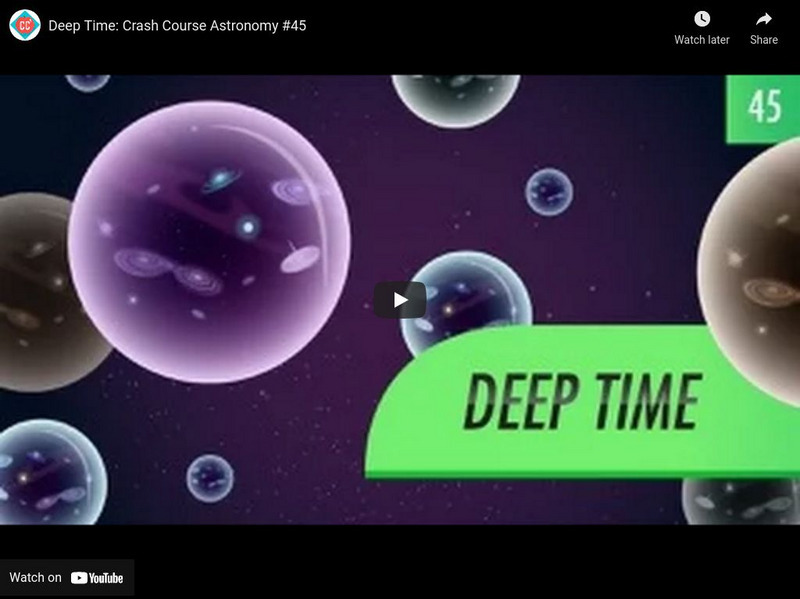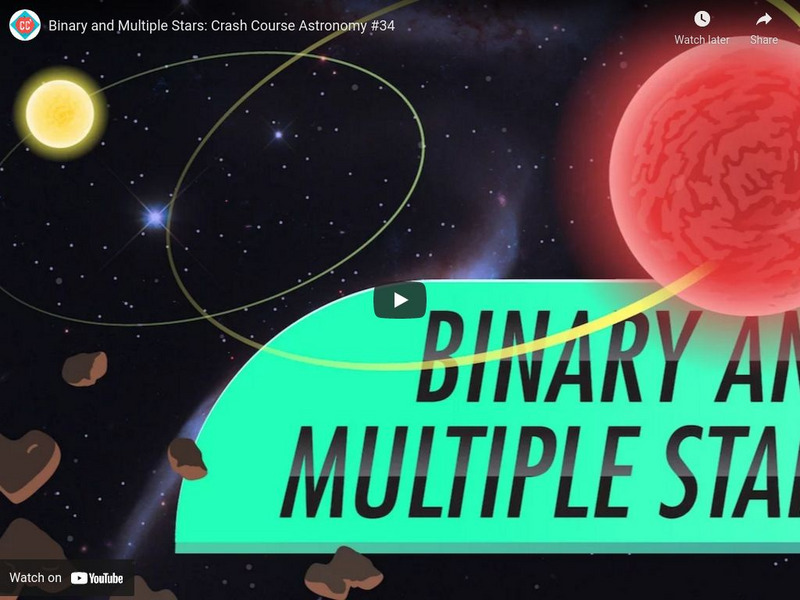Hi, what do you want to do?
Crash Course
The Milky Way
Where does Earth fit in the grand scheme of things? Find out in an intriguing video filled with facts and beautiful images! Learners journey to the center of the Milky Way to discover how our galaxy works. The narrator describes the...
Crash Course
Black Holes
Here's a black hole video that will definitely pull you in! Give pupils something to ponder as they explore the depths of the strangest entities in the universe. Topics include stellar mass and supermassive black holes, what you'd...
Crash Course
High Mass Stars
It's better to burn out than fade away! Viewers experience the birth of neutron stars and supernovae in a video that explains the life cycle of high mass stars. Learners see the conditions needed to produce these events, as well as...
MinutePhysics
What are Years... and the Galactic Supermassive Black Hole!
Everything is relative ... including the length of a year! Physics students explore time on a galactic scale in an animated video. The resource focuses on the tropical year upon which our calendar is based, galactic years, and the length...
PBS
Singularities Explained
Math versus physical reality ... who wins? A short video discusses singularities, starting with division by zero in rational functions and moving on to real-world examples. It covers population growth doomsday equations, Navier-Stokes...
SciShow
Gravitation: The Four Fundamental Forces of Physics #3
The Newtonian theory and the Einstein theory of gravity are the focus of a video that examines the details of each and includes the drawbacks of them as well — a great, well-rounded lesson!
DoodleScience
Life Cycle of Stars
Introduce your young astronomers to the life cycle of stars, from protostar to either white dwarf or black hole, with a short video that provides a brief overview of the process.
Crash Course Kids
Orbits Are Odd
Are the other orbits taking place in the universe similar or different to Earth's orbit around the sun and the moon's orbit around Earth? This is the focus of a video that explains all different types of orbits out there, including black...
Curated OER
Black Holes
What is a black hole? Learn about frame dragging, space-time, cosmic strings, and what they mean to time-travelers. This is a very interesting clip that uses CG graphics, scientific discussion, and comprehensive narration to postulate...
Khan Academy
Supernova (Supernovae), Stars, Black Holes and Galaxies, Cosmology and Astronomy
How does a massive star go supernova? This video is a follow-up to the Khan Academy video on the life cycle of massive stars, explaining the chemical collapse that results in a supernova. Sal explains the process with neutron stars and...
Khan Academy
Why Cepheids Pulsate, Stars, Black Holes and Galaxies, Cosmology and Astronomy
Classical Cepheids are supermassive stars that are used to determine distances to galaxies within a local group. Sal explains why Cepheid variables occur, how they are used to determine distances, and the chemistry that creates the...
Curated OER
Galaxies, Part 2 of 3
Part two of this three-part series asks us to think what life would be like if we lived in a binary star system. We are also introduced to black holes and Einstein's theory of relativity. A great clip shown in its three-part entirety or...
Curated OER
Galaxies, Part 3 of 3
Part three concludes "A Practical Guide to the Universe," completing the description of the Big Bang Theory and what it means. This episode touches on light travel, light speed, and what that means in relation to what we see. While this...
TED-Ed
Is Space Trying to Kill Us?
Taking somewhat of a humorous, paranoid viewpoint, this video explores the question of whether or not space objects are likely to take us out. From asteroids, to the sun dying out, to the Milky Way's supermassive black hole, the...
Curated OER
Beyond Einstein: Part II
Go deeper with the NASA program "Beyond Einstein" and discover the scientific foundations that are used along side observations to prove theories Einstein never dreamed of. This is part two of a two-part series on NASA's newest programs...
Science for Kids
Science Kids: Space Videos: Black Hole Destroying a Star
Narrated animation of a star breaking up as it is destroyed by the gravitational pull of a black hole. (Length: 1 min. 46 sec.)
PBS
Pbs Nova: Monster of the Milky Way
Does a supermassive black hole lurk at the center of our galaxy? Watch this 7-oart Nova video to learn more.
PBS
Pbs Learning Media: Monster Black Hole in Galaxy M84
This animation by Thomas Goertel of the Space Telescope Science Institute is an artist's conception of a spiral galaxy harboring a super-massive black hole. Observe how the material rotates faster the closer it is to the nucleus.
PBS
Pbs Learning Media: Crash Course Astronomy: Black Holes
Stellar mass black holes form when a very massive star dies, and its core collapses. Black holes come in different sizes, but for all of them, the escape velocity is greater than the speed of light, so nothing can escape, not matter or...
University of Nottingham
Sixty Symbols: Symbols of Physics and Astronomy: Black Holes and the Schwarzschi
By calculating the Schwarzschild radius, a University of Nottingham astronomer figures out how small the Earth would have to become in order to become a black hole. Learn what the Schwarzschild radius is, how it came to be, and how it is...
Science Friday Initiative
Science Friday: Attack of the Black Hole
Astronomers have captured an image of a jet of radiation leaving a black hole at the center of one galaxy to strike the edge of neighboring galaxy.
NASA
Nasa: Space Place: Space Place in a Snap: What Is a Black Hole?
In this episode, find out how what black holes are, how they can form, and why they are so cool!
Crash Course
Crash Course Astronomy #45: Deep Time
Are the Universe's days are numbered? Learn about the expected fate of stars, protons, matter, and black holes. [15:15]
Crash Course
Crash Course Astronomy #34: Binary and Multiple Stars
Stellar mass black holes form when a very massive star dies, and its core collapses. Black holes come in different sizes, but for all of them, the escape velocity is greater than the speed of light, so nothing can escape, not matter or...



























